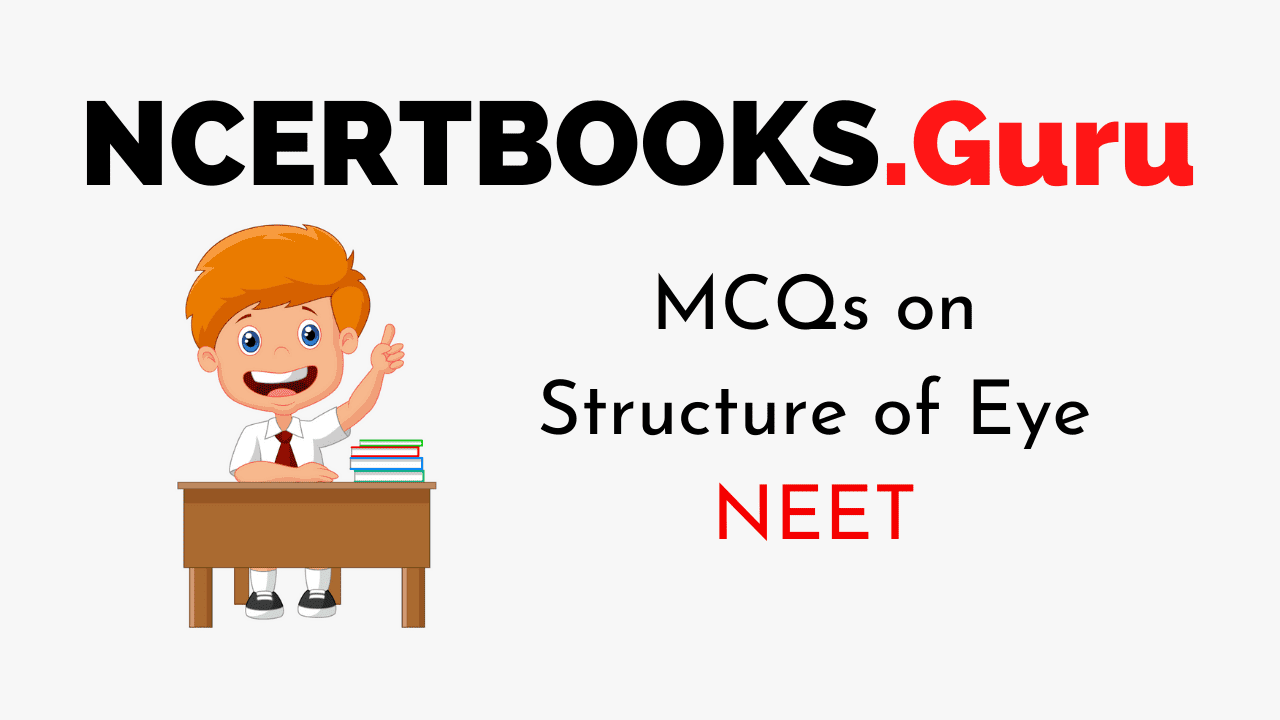NEET Biology is the scoring paper in the medical entrance examination. Here, you will discover the NEET Biology MCQ Questions for all Concepts as per the latest syllabus. Practice more on a regular basis with these NEET Biology objective questions on air pollution and improve your subject knowledge & problem-solving skills along with time management. NEET Biology Structure of Eye Multiple Choice Questions make you feel confident in answering the question in the exam & increases your scores to high.
MCQs on Structure of Eye
1. The main function of the cornea present in the human eye is
(a) structural support to the eye
(b) bends light before it reaches the lens
(c) changes the shape of the lens enabling image to be focused on the retina
(d) contains a concentrated amount of cone cells on the correct orientation
Answer
Answer: (b)
2. The type of cells found in retina are
(a) Purkinje cells
(b) Schwann cells
(c) Neuroglial cells
(d) Amacrine cells
Answer
Answer: (d)
3. Where will the image of a distant object be formed when a person using a concave lens to correct vision, is not using glasses?
(a) behind retina
(b) in front of the retina
(c) on the blindspot
(d) on the yellow spot
Answer
Answer: (b)
4. A cornea transplant is never rejected in humans because
(a) it consists of enucleated cells
(b) it is a non-living layer
(c) it has no blood supply
(d) its cells are least penetrable by bacteria
Answer
Answer: (c)
5. This is an incorrect statement
(a) rhodopsin is the purplish-red protein situated in rods only
(b) Retinal is a derivative of Vitamin C
(c) Retinal is the light-absorbing part of visual photopigments
(d) the rods in the retina have rhodopsin, a photopigment while cones have three different photopigments
Answer
Answer: (b)
6. The fovea is the mammalian eye is the centre of the visual field wherein
(a) the optic nerve exits the eye
(b) only rods are found
(c) more rods than cones are found
(d) no rods but a high density of cones occur
Answer
Answer: (d)
7. In the human eye, the photosensitive compound is composed of
(a) guanosine and retinol
(b) transducin and retinene
(c) opsin and retinol
(d) opsin and retinal
Answer
Answer: (d)
8. The eye lens is
(a) Concave
(b) Convex
(c) Biconcave
(d) Biconvex
Answer
Answer: (d)
9. The persistence of vision for the human eye is
(a) 1/6th of a second
(b) 1/10th of a second
(c) 1/16th of a second
(d) 1/18th of a second
Answer
Answer: (c)
10. What does the tapetum lucidum do?
(a) it is the coloured part of the eye
(b) gives animals night vision
(c) transparent jelly-like fluid
(d) it is the area where the optic never attaches
Answer
Answer: (b)
11. The innermost layer and the most delicate layer of the eyeball where the photoreceptors are located are
(a) Chloroid
(b) Sclera
(c) Cornea
(d) Retina
Answer
Answer: (d)
12. This part of the eye dilates and contracts based on the environment
(a) Sclera
(b) Cornea
(c) Lens
(d) Pupil
Answer
Answer: (d)
13. The transparent lens in the human eye is held in its place by
(a) smooth muscles attached to the iris
(b) ligaments attached to the ciliary body
(c) ligaments attached to the iris
(d) smooth muscles attached to the ciliary body
Answer
Answer: (b)
14. The eye of octopus and the eye of cats show different patterns of structure, yet they perform similar functions. This is an example of
(a) Homologous organs that have evolved due to convergent evolution
(b) Homologous organs that have evolved due to divergent evolution
(c) Analogous organs that have evolved due to convergent evolution
(d) Analogous organs that have evolved due to divergent evolution
Answer
Answer: (c)
15. Which of these colours is least scattered by dust, fog, smoke?
(a) Yellow
(b) Red
(c) Blue
(d) Violet
Answer
Answer: (b)
